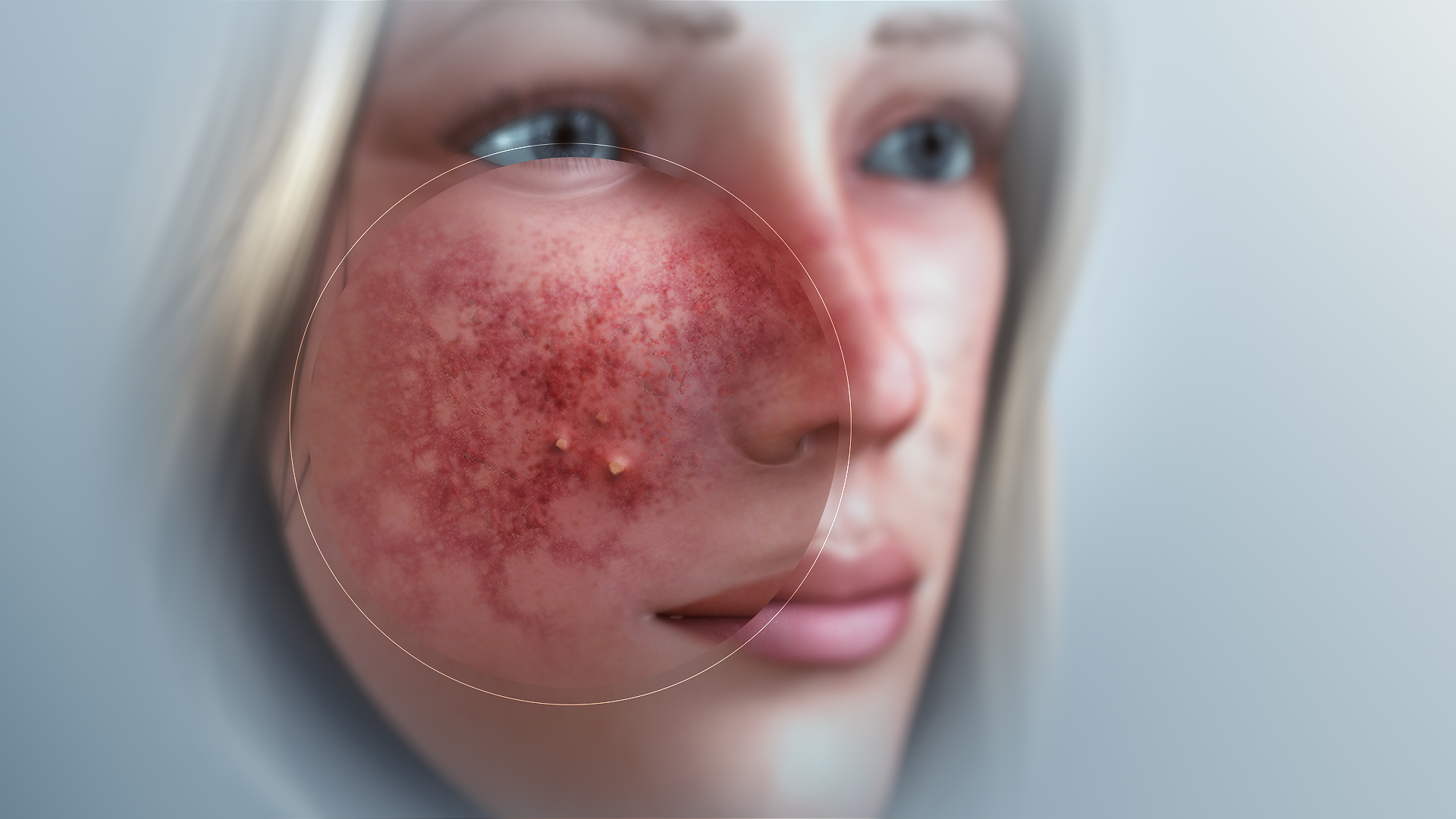Rosacea is a skin disease characterized by redness, particularly in the central regions of the face. The nose, cheeks, forehead and chin are the key hotspots where rosacea becomes prominent due to increased blood flow. Most people who acquire rosacea lie in the age group of 30-50 years. Women are at a slightly greater risk, but severe cases often occur in men. It is also an observation that people with a fair complexion are more prone to rosacea.

3D Medical Animation still showing Rosacea infected face
Signs and symptoms of it go beyond blushing and flushing. For this reason, scientists have distinguished the skin condition into 4 subtypes. Some people may have more than one rosacea subtype at the same time and each subtype requires a different treatment approach.
Classification (Types)
Erythrotelangietatic or Vascular
Besides redness, there occurs swelling and on and off acne-like breakouts. Skin becomes oily, with raised patches called plaques.
Papulopustular
Marked by visible blood vessels, burning sensation, dryness, roughness or scaling.
Phymatous
This subtype is rare. In this the skin thickens (commonly around the nose) and has a bumpy texture. The condition is known as rhinophyma. Skin becomes oily and pores appear large.
Ocular
As named, it affects the eye region. Redness, swelling and irritation around the eyelids is common and person may have what looks like a sty. Eyes burn and itch, become sensitive to light, leading to blurry vision.
Causes
While the cause of the condition is a mystery, certain stimulants of it could be exposure to extreme heat or cold, stress- both physical (exercise) and mental, spicy food, alcohol, caffeine, etc. Besides, some topically used steroids and medications used for acne or wrinkle treatment are also known to trigger rosacea flares. Other plausible causes are listed below:
- Some patients (especially those with steroid-induced rosacea) are observed to have increased numbers of the Demodex mite in their skin, suggesting a possible role for these mites in the induction of this condition.
- Bacillus oleronius is also known to be sensitive to the antibiotics used to treat rosacea, and hence, may be a causative agent for it.
- Intestinal infection by H pylori may be associated with rosacea. The bacterial growth is seen to be more prevalent in rosacea patients and studies support that antibiotic treatments work more effectively in such patients. So gut bacteria may play a role in the pathogenesis of rosacea lesions.
- An antimicrobial protein called cathelicidin is also considered a potential cause of rosacea as it produces high levels of stratum corneum tryptic enzymes, that shed out the outer layer of skin and, consequently, lead to redness.
- Since rosacea runs in families, it may also have genetic roots.
Treatment
Depending on the subtype and the extent of severity, its treatment may vary from individual to individual. In fact, mild cases may not need any medications at all; they can be managed by simply identifying one’s triggers and avoiding them.
Metronidazole compounds work topically through anti-inflammatory mechanisms, while azelaic acid preparations have shown evidences of decreased cathelicidin production. Oral antibiotics of the tetracycline class work through anti-inflammatory actions rather than through their antibacterial capabilities.
Single wavelength dermatological vascular laser or broad spectrum intense pulsed light machines can help curb the redness associated with it. Excessive vascularization of the skin is controlled when the light penetrates the epidermis into the dermal capillaries, where oxygenated hemoglobin molecules absorb it. The heated up oxyhemoglobin damages the capillaries.
Carbon dioxide lasers are used to remove excess tissue caused by phymatous rosacea. Besides, low-level light therapies and photorejuvenation have also reportedly improved rosacea cases.
Conclusion
It is a chronic condition that affects everyone differently. It is important for the individual to figure out the traits of their rosacea in order to manage them effectively.
Disclaimer: The information in no way constitutes, or should be construed as medical advice. Nor is the above article an endorsement of any research findings discussed in the article an endorsement for any of the source publications.

Freckles: Types, Causes, and Treatment
Freckles appear as clusters of circular, brownish-colored spots, more prominently on the faces of light-skinned people. They occur as a result of increased melanin production. Read More..








